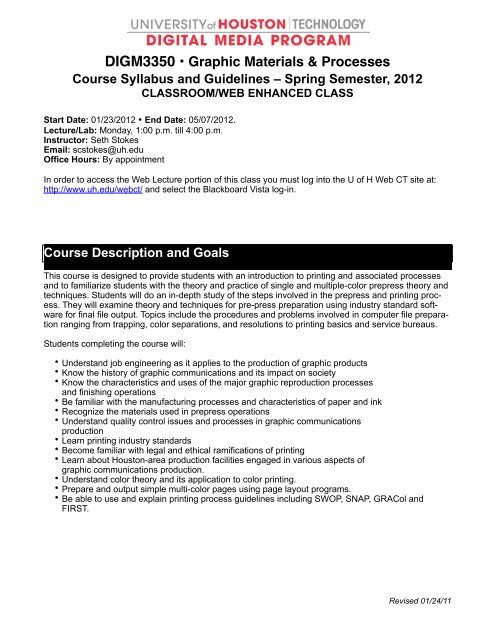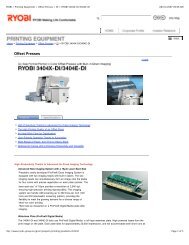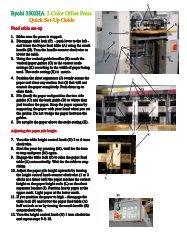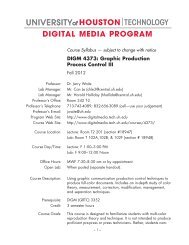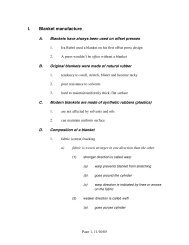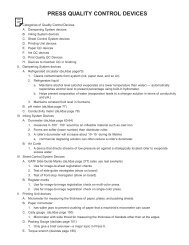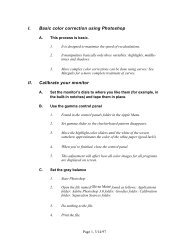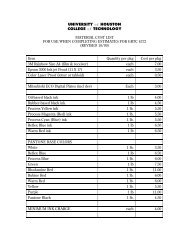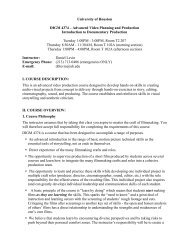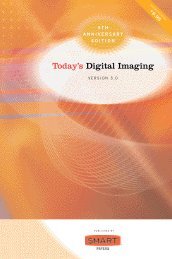Syllabus - Graphic Communications Technology - University of ...
Syllabus - Graphic Communications Technology - University of ...
Syllabus - Graphic Communications Technology - University of ...
Create successful ePaper yourself
Turn your PDF publications into a flip-book with our unique Google optimized e-Paper software.
DIGM3350 • <strong>Graphic</strong> Materials & Processes<br />
Course <strong>Syllabus</strong> and Guidelines – Spring Semester, 2012<br />
CLASSROOM/WEB ENHANCED CLASS<br />
Start Date: 01/23/2012 • End Date: 05/07/2012.<br />
Lecture/Lab: Monday, 1:00 p.m. till 4:00 p.m.<br />
Instructor: Seth Stokes<br />
Email: scstokes@uh.edu<br />
Office Hours: By appointment<br />
In order to access the Web Lecture portion <strong>of</strong> this class you must log into the U <strong>of</strong> H Web CT site at:<br />
http://www.uh.edu/webct/ and select the Blackboard Vista log-in.<br />
Course Description and Goals<br />
This course is designed to provide students with an introduction to printing and associated processes<br />
and to familiarize students with the theory and practice <strong>of</strong> single and multiple-color prepress theory and<br />
techniques. Students will do an in-depth study <strong>of</strong> the steps involved in the prepress and printing process.<br />
They will examine theory and techniques for pre-press preparation using industry standard s<strong>of</strong>tware<br />
for final file output. Topics include the procedures and problems involved in computer file preparation<br />
ranging from trapping, color separations, and resolutions to printing basics and service bureaus.<br />
Students completing the course will:<br />
• Understand job engineering as it applies to the production <strong>of</strong> graphic products<br />
• Know the history <strong>of</strong> graphic communications and its impact on society<br />
• Know the characteristics and uses <strong>of</strong> the major graphic reproduction processes<br />
and finishing operations<br />
• Be familiar with the manufacturing processes and characteristics <strong>of</strong> paper and ink<br />
• Recognize the materials used in prepress operations<br />
• Understand quality control issues and processes in graphic communications<br />
production<br />
• Learn printing industry standards<br />
• Become familiar with legal and ethical ramifications <strong>of</strong> printing<br />
• Learn about Houston-area production facilities engaged in various aspects <strong>of</strong><br />
graphic communications production.<br />
• Understand color theory and its application to color printing.<br />
• Prepare and output simple multi-color pages using page layout programs.<br />
• Be able to use and explain printing process guidelines including SWOP, SNAP, GRACol and<br />
FIRST.<br />
Revised 01/24/11
Textbooks and Materials<br />
Most <strong>of</strong> the reading assignments for this class will be posted on the Web site.<br />
You will also need some form <strong>of</strong> removable media to back up your work in class. You should bring the<br />
back-up media to every class. You are responsible for creating back-up files <strong>of</strong> all <strong>of</strong> your work.<br />
Textbooks:<br />
Getting it Printed: Kenly, E., and Beach, M. Publisher:<br />
HOW Design Books. ISBN 1-58180-577-2<br />
(±$21.77 on amazon.com) REQUIRED<br />
Pocket Pal: A <strong>Graphic</strong> Arts Production Handbook<br />
(Paperback) by Michael H. Bruno (Editor)<br />
Publisher: <strong>Graphic</strong> Arts Technical Foundation; 18th<br />
edition (October 1, 2000) ISBN: 0883623382 (Required)<br />
NOTE: You may purchase the Pocket Pal<br />
when we tour the Museum <strong>of</strong> Printing History.<br />
Materials: In addition to the textbooks you will need a three ring binder to keep assignments and handout<br />
materials;<br />
Course/Lab Policies<br />
Class Withdrawal: The State <strong>of</strong> Texas has begun to impose penalties on students who drop courses<br />
excessively. That is, if you repeat the same course more than twice, you have to pay extra tuition. In<br />
addition, as <strong>of</strong> Fall 2007, students are limited to no more than SIX total course withdrawals throughout<br />
their educational career at a Texas public college or university.<br />
In order to withdraw from your class, you MUST contact your pr<strong>of</strong>essor and this must be done<br />
PRIOR to the withdrawal deadline to receive a “W” on your transcript. If you do not withdraw before<br />
the deadline, you will receive the grade that you have earned by the end <strong>of</strong> the semester. Zeros<br />
averaged in for required assignments/tests not submitted will lower your semester average significantly,<br />
most likely resulting in a failing grade (“F”).<br />
Plagiarism and Scholastic Dishonesty: A. definition <strong>of</strong> plagiarism as it relates to digital imaging: to<br />
pass <strong>of</strong>f (the ideas <strong>of</strong> another) as ones own: use without crediting the source: present as new and original<br />
an idea derived from an existing source.<br />
Assignments<br />
No make-up tests or extended deadlines will be given unless special arrangements have been made<br />
with the instructor in advance.<br />
A major part <strong>of</strong> this class is attending the field trips and reporting on what you observe. These reports<br />
are due at the beginning <strong>of</strong> the class following the field trip.<br />
Attendance<br />
Regular and punctual attendance is required <strong>of</strong> each student. Students will be permitted a total <strong>of</strong> three<br />
unexcused absences from class. After three unexcused absences the student’s final grade will be low-<br />
DIGM 3350 <strong>Graphic</strong> Materials and Processes Spring 2012! Page 2
ered by one letter grade for each subsequent absence. In addition to the <strong>University</strong>’s policy, it is the instructor’s<br />
decision as to what will constitute an excused absence based on academic and pr<strong>of</strong>essional<br />
growth opportunities outside the class. If there is any question as to the nature <strong>of</strong> the absence, the student<br />
should seek out the instructor prior to the absence.<br />
In accordance with <strong>University</strong> policy students will be informed in advance, whenever possible, <strong>of</strong> any<br />
cancelled class meetings and are expected to wait no longer than 15 minutes for an instructor if there<br />
has been no announcement. If a student is more than 15 minutes tardy for class he/she will not receive<br />
attendance credit for that class.<br />
Excused Absences are defined as follows:<br />
• Illness with a doctor’s note<br />
• Participation in a university function with a note from the advisor<br />
• Death in the family with appropriate documentation<br />
Submitting Late Assignments<br />
One <strong>of</strong> the most important requirements in the real world is dependability. When you are working with<br />
others it is important that you meet the specified deadline. For this reason, this class also emphasizes<br />
the importance <strong>of</strong> turning in your work as scheduled. I understand that there are times when "bad<br />
things happen to good people" but it is important that you plan for possible problems. If you wait until<br />
the last minute to complete an assignment, I can almost promise you that something will happen that<br />
you did not think would happen. Not only should you have a "plan B" in case <strong>of</strong> problems, but also, you<br />
should anticipate that you might have to use it. However, please keep in mind that it is better to complete<br />
an assignment late than not to complete it at all. If you turn in an assignment late, there will be<br />
points deducted from the assignment because it is late, however, you will still receive some points instead<br />
<strong>of</strong> no points which is what you will get if you don't submit the assignment<br />
There is a great deal <strong>of</strong> work for this course. You can very quickly fall behind. Unless otherwise noted,<br />
an assignment will be considered late if not turned in by the day and time it is due. Assignments will be<br />
reduced one letter grade for each lab/class period the assignment is late.<br />
Students With Disabilities<br />
Any student who may be in need <strong>of</strong> additional help under the ADA guidelines should contact the<br />
instructor directly after the first class meeting.<br />
DIGM 3350 <strong>Graphic</strong> Materials and Processes Spring 2012! Page 3
Grading<br />
Your grades will be based on participation, completion <strong>of</strong> the assignment projects in a timely manner,<br />
quizzes and a final project. The projects must be completed to the satisfaction <strong>of</strong> the instructor. If they<br />
are not, then you will have an opportunity to resubmit as long as it is within the time allotted for that assignment.<br />
Grading: Item Total<br />
Exercises 200<br />
Midterm Examination 200<br />
Final Examination 300<br />
Field Trip Reports 200<br />
Attendance 100<br />
Using this criteria, your work will be assigned letter grades, which will be calculated by using the following<br />
scale: A= 94-100; A- = 90-93; B+ = 87-89; B = 84-86; B- = 80-83; C+ = 77-79; C = 74-76;<br />
C- = 70-73; D+ = 67-69; D = 64-66; D- = 60-63.<br />
Extra Credit: There will also be additional extra credit assignments available during the semester.<br />
Membership in the IGAEA UH student’s chapter adds two points to final grade. Attendance at the<br />
IGAEA UH meetings adds one point to final grade per meeting. These extra credit assignments will add<br />
to your total points and could make the difference between one letter grade and another.<br />
You also have a protected grade sheet that reflects your current grade and the assignments that you<br />
have submitted. You will find this grade sheet in your Blackboard class page.<br />
Important Dates to Remember<br />
January 23! .................................. Class Begins.<br />
January 24! .................................. Last day to drop/add/swap.<br />
February 1..................................Official Date <strong>of</strong> Record. ORD (Students will be withdrawn who<br />
have not participated in class.) Last day to withdraw without<br />
receiving a grade.<br />
March 12-17! ............................... Spring Break (U <strong>of</strong> H Campus is closed.)<br />
April 3! ......................................... Last Day for Administrative/Student Withdrawals-with a W<br />
April 30! ....................................... Last Day <strong>of</strong> Class.<br />
May 7<br />
Final Exam Period. See Final Exam schedule on Web site.<br />
DIGM 3350 <strong>Graphic</strong> Materials and Processes Spring 2012! Page 4
PROPOSED SCHEDULE OF TOPICS<br />
This schedule is a guideline only and may be altered at any time at the instructor’s discretion.<br />
Week 1: (1/23) Orientation, Printing History and Workflow<br />
Student Pr<strong>of</strong>ile sheets, and introductions, Discuss course procedures, policies, textbooks, supplies and<br />
course requirements,<br />
Exercise 1A: Write at least a 200-word essay on you and what you expect to learn in this class. Include<br />
background information on yourself, and your life, any experience you may have had in the graphics<br />
field and other experiences in your life (jobs, family, education, etc. that you think would be interesting<br />
to your fellow students) Spell and grammar check, Post this essay to the class Web site.<br />
Exercise 1B: Read the essays posted by the other members <strong>of</strong> the class and reply to at least three <strong>of</strong><br />
them.<br />
Week 2: (1/30) Museum <strong>of</strong> Printing History<br />
We will be going to the Museum <strong>of</strong> Printing History, where we will have an opportunity to different printing<br />
presses and see a film on the way the printing process developed. I would suggest that you meet at<br />
West Loop and carpool together.<br />
Reading Week 2: Read the links posted on the class website.<br />
Exercise 2: Write a Report on the Museum <strong>of</strong> Printing History Field Trip<br />
1. Where, when, and who;<br />
2. What we saw:<br />
3. Why and How the trip impacted me.<br />
There is an outline <strong>of</strong> the field trip report available on the class website. The document is called Field<br />
Trip Outline. Use it!<br />
Use the APA stylebook as a reference. Reports will be evaluated based upon content and English usage.<br />
A document on the website entitled Field Trip Evaluation Form describes how these reports will be<br />
graded.<br />
Field trip reports are due at the beginning <strong>of</strong> the class session following the field trip.<br />
* Please bring $2 (correct change only) for admission to the Museum <strong>of</strong> Printing History.<br />
DIGM 3350 <strong>Graphic</strong> Materials and Processes Spring 2012! Page 5
Week 3: (2/6) Overview <strong>of</strong> Printing Processes<br />
(Classroom)<br />
Discussion <strong>of</strong> Letterpress, Screen Printing (Serigraphy).<br />
Reading Week 3: Kenly and Beach, chapters 1, 3, 4, and 7<br />
Week 4: (2/13) Field trip to a LetterPress Shop<br />
(Workhorse Prints - Houston, TX)<br />
Order Entry; Preflighting; Prepress; Presses; Bindery; Finishing; Distribution and Picking.<br />
Exercise 4: Write a Report on Workhorse.<br />
1. Where, when, and who;<br />
2. What we saw:<br />
3. Why and How the trip impacted me.<br />
There is an outline <strong>of</strong> the field trip report available on the class website. The document is called Field<br />
Trip Outline. Use it!<br />
Use the APA stylebook as a reference. Reports will be evaluated based upon content and English usage.<br />
A document on the website entitled Field Trip Evaluation Form describes how these reports will be<br />
graded.<br />
Field trip reports are due at the beginning <strong>of</strong> the class session following the field trip.<br />
and Prepress.<br />
Week 5: (2/20) Field trip to a Screen Print Shop<br />
(ADPower - Houston, TX)<br />
Order Entry; Preflighting; Prepress; Screen Presses Finishing and shipping.<br />
Exercise 5: Write a Report on AdPower.<br />
1. Where, when, and who;<br />
2. What we saw:<br />
3. Why and How the trip impacted me.<br />
There is an outline <strong>of</strong> the field trip report available on the class website. The document is called Field<br />
Trip Outline. Use it!<br />
Use the APA stylebook as a reference. Reports will be evaluated based upon content and English usage.<br />
A document on the website entitled Field Trip Evaluation Form describes how these reports will be<br />
graded.<br />
Field trip reports are due at the beginning <strong>of</strong> the class session following the field trip.<br />
DIGM 3350 <strong>Graphic</strong> Materials and Processes Spring 2012! Page 6
Week 6: (2/27) Mid-Term Exam Study Session<br />
This class will be to answer your questions about the tours and materials to assure you are ready for<br />
the Mid-Term exam.<br />
Week 7: (3/5) Mid-Term Exam<br />
You will take your mid-term exam this week.<br />
Week 8: (3/12) Spring Break<br />
The <strong>University</strong> will be closed for this week.<br />
Week 9: (3/19) Printing Process Overviews (Classroom)<br />
Discussion <strong>of</strong> Flexography, Ink jet Printing, Large Format Printers/Pro<strong>of</strong>ers, Intaglio Printing Processes,<br />
Printing Processes: Advances in <strong>Technology</strong>, Sheetfed Offset Lithography, Variable Data Printing and<br />
Xerographic Printing.<br />
Reading Week 3: Kenly and Beach, chapters 1, 3, 4, and 7<br />
Week 10: (3/26) Field Trip to Flexographic Printing Plant<br />
(Gulf States Label – Houston, TX)<br />
We will be touring and reviewing the flexographic printing process at one <strong>of</strong> Houston’s only shops.<br />
Exercise 10: Write a Report on Gulf States Label.<br />
1. Where, when, and who;<br />
2. What we saw:<br />
3. Why and How the trip impacted me.<br />
There is an outline <strong>of</strong> the field trip report available on the class website. The document is called Field<br />
Trip Outline. Use it!<br />
Use the APA stylebook as a reference. Reports will be evaluated based upon content and English usage.<br />
A document on the website entitled Field Trip Evaluation Form describes how these reports will be<br />
graded.<br />
Field trip reports are due at the beginning <strong>of</strong> the class session following the field trip.<br />
DIGM 3350 <strong>Graphic</strong> Materials and Processes Spring 2012! Page 7
Week 11: (4/2) Field Trip to Sheetfed Offset Printing Plant<br />
(CPY - Houston, TX)<br />
We will tour a Consolidated <strong>Graphic</strong>s location named “CPY”. We will focus on the <strong>of</strong>fset sheetfed departments,<br />
but will also be touring their web <strong>of</strong>fset and digital departments as well.<br />
Exercise 11: Write a Report on CPY.<br />
1. Where, when, and who;<br />
2. What we saw:<br />
3. Why and How the trip impacted me.<br />
There is an outline <strong>of</strong> the field trip report available on the class website. The document is called Field<br />
Trip Outline. Use it!<br />
Use the APA stylebook as a reference. Reports will be evaluated based upon content and English usage.<br />
A document on the website entitled Field Trip Evaluation Form describes how these reports will be<br />
graded.<br />
Field trip reports are due at the beginning <strong>of</strong> the class session following the field trip.<br />
Week 12: (4/9) Field Trip to Web Offset Printing Plant<br />
(Southeast Media - Houston, TX)<br />
We will tour the web <strong>of</strong>fset department Southeast Media. We will focus on the web <strong>of</strong>fset department,<br />
but will also be touring their wide format and digital departments as well.<br />
Exercise 11: Write a Report on Southeast Media.<br />
1. Where, when, and who;<br />
2. What we saw:<br />
3. Why and How the trip impacted me.<br />
There is an outline <strong>of</strong> the field trip report available on the class website. The document is called Field<br />
Trip Outline. Use it!<br />
Use the APA stylebook as a reference. Reports will be evaluated based upon content and English usage.<br />
A document on the website entitled Field Trip Evaluation Form describes how these reports will be<br />
graded.<br />
Field trip reports are due at the beginning <strong>of</strong> the class session following the field trip.<br />
DIGM 3350 <strong>Graphic</strong> Materials and Processes Spring 2012! Page 8
Week 13: (4/16) Field Trip to Digital Printing Plant<br />
(ImageSet Digital – Houston, TX)<br />
We will tour a full digital facility that focuses on short-run digital and wide-format printing.<br />
Exercise 6: Write a Report on ImageSet Digital.<br />
1. Where, when, and who;<br />
2. What we saw:<br />
3. Why and How the trip impacted me.<br />
There is an outline <strong>of</strong> the field trip report available on the class website. The document is called Field<br />
Trip Outline. Use it!<br />
Use the APA stylebook as a reference. Reports will be evaluated based upon content and English usage.<br />
A document on the website entitled Field Trip Evaluation Form describes how these reports will be<br />
graded.<br />
Field trip reports are due at the beginning <strong>of</strong> the class session following the field trip.<br />
Week 14: (4/23) Materials, Quality Control, Variable Data & Cross<br />
Media Marketing<br />
(Classroom)<br />
We will discuss the various materials used in the printing process, the quality control standards as well<br />
as the usage <strong>of</strong> Variable Data printing and the role it plays in Cross Media Marketing. With the increase<br />
in usage and print becoming only one <strong>of</strong> the chosen methods <strong>of</strong> communications, the inter-relationships<br />
between the different methods is critical to understand.<br />
Week 15: (4/30) Final Review<br />
We will review the items that were covered in the course as well as giving you an idea <strong>of</strong> what the final<br />
exam will contain.<br />
Week 16: (5/7) Final Exam<br />
We will have our final exam at the regularly scheduled exam time.<br />
DIGM 3350 <strong>Graphic</strong> Materials and Processes Spring 2012! Page 9
DIGM 3350 <strong>Graphic</strong> Materials and Processes Spring 2012! Page 10
Student Information<br />
Course: DIGM 3350 <strong>Graphic</strong> Materials and Processes ! ! !<br />
Semester: Spring Year: 2012<br />
Please complete this form. It will help your instructor become familiar with your background and course<br />
goals and assist the <strong>Graphic</strong> <strong>Technology</strong> Department in designing courses to meet the individual student’s<br />
needs. Of course, this data will remain confidential.<br />
Name:_____________________________________________________________________________<br />
! First Name!! ! M.I! Last Name! Nickname (If used)!<br />
Peoples<strong>of</strong>t # ___________________________________! !<br />
Address:___________________________________________________________________________<br />
! ! Street! ! ! ! ! City! ! ! State! ! Zip<br />
Home Phone: ________________________________ Work Phone:___________________________<br />
Email address (Please print clearly): ________________________@ __________________________<br />
Employer__________________________________________________________________________<br />
Job Title/Description:_________________________________________________________________<br />
What other Computer/<strong>Graphic</strong> Arts courses have you taken and where?<br />
__________________________________________________________________________________<br />
Have you used computers?_______ If so, what kind?_______________________________________<br />
What graphics/desktop publishing programs do you know?___________________________________<br />
__________________________________________________________________________________<br />
__________________________________________________________________________________<br />
Do you have a background in typesetting, graphic design, commercial or fine art, printing, architecture,<br />
drafting or any form <strong>of</strong> computer graphics?_______ If so, please elaborate:<br />
_________________________________________________________________________________<br />
Please rate your skills in the following programs with 1 being novice and 5 expert:<br />
Photoshop ______ Illustrator _______ InDesign ________ Acrobat _______<br />
DIGM 3350 <strong>Graphic</strong> Materials and Processes Spring 2012! Page 11
DIGM 3350 <strong>Graphic</strong> Materials and Processes Spring 2012! Page 12
DIGM 3350 <strong>Graphic</strong> Materials and Processes Spring 2012! Page 13
Acknowledgment <strong>of</strong> <strong>Syllabus</strong> and Release <strong>of</strong> Work Produced<br />
To receive credit for attendance, Please fill in this information and return this page to the<br />
instructor before leaving your first class.<br />
Student Name: _________________________________________________________________<br />
Student Peoples<strong>of</strong>t ID Number: ___________________________________________________<br />
Student email address: (Please Print Clearly) _________________________________________<br />
An agreement between The <strong>University</strong> <strong>of</strong> Houston and this student to use work produced by this<br />
student during the course <strong>of</strong> class activities.<br />
The student agrees to allow The <strong>University</strong> <strong>of</strong> Houston to use works created in this class in the<br />
following ways:<br />
1. Gallery Shows.<br />
2. On-line web sites sponsored by The <strong>University</strong> <strong>of</strong> Houston.<br />
3. In printed materials produced by the The <strong>University</strong> <strong>of</strong> Houston.<br />
4. Other materials used to promote the <strong>University</strong> and/or its programs.<br />
The <strong>University</strong> <strong>of</strong> Houston agrees:<br />
1. The student’s work will not be sold or <strong>of</strong>fered for sale without prior permission <strong>of</strong> the student.<br />
2. Ownership <strong>of</strong> the works remains with the student.<br />
3. The work will not be altered in any way except to optimize for display or for publication.<br />
4. The student will receive credit for their work when it is used as described.<br />
I have read, understand, and agree to abide by the policies or The <strong>University</strong> <strong>of</strong> Houston and the<br />
contents <strong>of</strong> the course syllabus. I have had the attendance policies explained to me and understand<br />
that I am responsible for keeping track <strong>of</strong> my absences and that I may be withdrawn from<br />
this class if I exceed the limits, regardless <strong>of</strong> reason. I further agree to the above terms <strong>of</strong> use<br />
for any work created as a part <strong>of</strong> this class.<br />
Student Signature: _____________________________________<br />
Date: ________________<br />
DIGM 3350 <strong>Graphic</strong> Materials and Processes Spring 2012! Page 14


